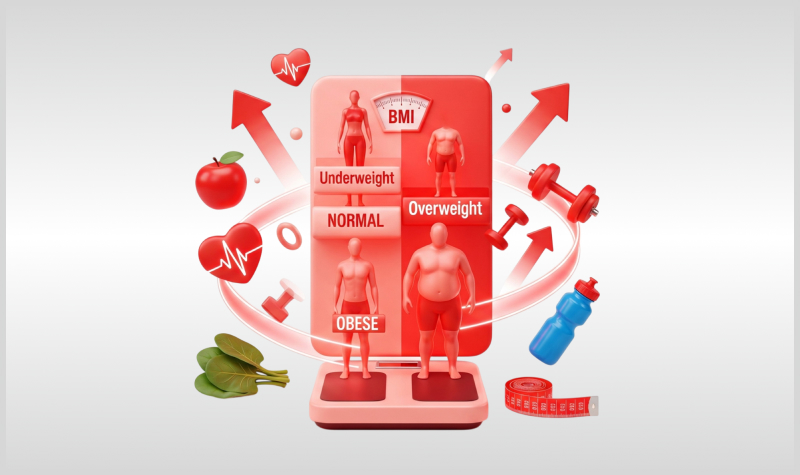What Is BMI, and How Is It Calculated?
BMI is a popular measure used to determine if a person has an appropriate weight for his or her height. It gives a simple numeric value that indicates whether one is underweight, normal weight, overweight, or obese. BMI is not perfect because it cannot make a distinction between muscle mass and fat mass, but it can be used as a useful first step for evaluating general weight-related health risk. The definition of BMI and the ability to calculate BMI enable a person to make the correct decisions in terms of diet, exercise, and lifestyle change to achieve the best health.
Understanding BMI Calculation
It is easy to compute BMI and can be done by a simple formula: weight in kg divided by the square of height in meter (kg/m²).For example, if someone weighs 70 kg and stands at 1.75 meters in height, then the BMI would be 70 ÷ (1.75 × 1.75) = 22.86. Alternatively, BMI can be calculated by pounds and inches by the formula of [weight in pounds ÷ (height in inches × height in inches)] × 703. The outcome provides a baseline by which to measure different individuals regardless of age or gender, thereby creating an easy and effective method of measurement.
Accurate BMI calculation has to be performed in such a way that the smallest calculation mistake in height or in weighing may affect the end BMI value. That is why equipment for measures and measures themselves should be accurate. The majority of the health centers and fitness centers, including V Sparkel, offer professional BMI measures where experts don't simply observe the proportion of weight and height but also other composition characteristics. Regular BMI tracking can help individuals monitor their Weight loss control programand identify potential health risk factors at the initial stages.
BMI Categories and Their Importance

Ranges are used for BMI to classify weight status and potential associated health consequences in each range. In standard recommendations, less than 18.5 is underweight, 18.5–24.9 is within the healthy or normal BMI range, 25–29.9 is within the BMI for overweight, and 30 and above is obese. Ranges provide a ready reference for patient and medical use to assess whether modification of lifestyle is necessary.
It is also crucial to understand the BMI categories because they say more than the actual number on the scale. For example, being in the overweight BMI category can increase the risk of getting diseases such as heart disease, diabetes, and high blood pressure. Conversely, being underweight could reveal nutrient deficiency or other diseases. BMI categories, and coordinates other health tests, inform the creation of customized nutrition and exercise programs that address each individual's unique needs.
Why is it so important to Understand Your Overweight BMI Range
It is important to know whether you fall under the overweight BMI range to prevent long-term health issues. Individuals in this category may not always be aware of having direct health issues, but over time, excess body weight can lead to metabolic diseases, cardiovascular diseases, and joint stress. Having such knowledge in advance allows for early intervention through the right diet plans, exercise routines, and wellness programs
Awareness of the overweight BMI range also promotes healthy lifestyle maintenance. With the guidance of nutritionists and fitness experts, individuals can create realistic goals to work towards progressively achieving an ideal BMI. In combination with lifestyle changes, this information benefits not only weight loss but also overall health, energy, and mood. Regular screening of BMI and staying in the recommended ranges ensures a healthy, balanced life.
Conclusion
BMI is a helpful assessment of weight status based on the height and weight ratio and graded to highlight possible health risks. Becoming aware of calculating BMI, categories of BMI, and the significance of the BMI range, overweight can help individuals make an informed choice towards a better life. Regular monitoring and proper nourishment at V Sparkel, we help you to maintain an optimal BMI and promote overall well-being.
FAQs
1. How do I calculate my BMI?
To find your BMI, divide your weight in kilograms by your height in meters squared (BMI = weight ÷ height²). In establishing if your weight is healthy, it helps to estimate body fat.
2. What is a good BMI for my age?
No matter what their age is, most adults have an average body mass index (BMI) between 18.5 and 24.9. A bit of increase can be tolerated in older people but a lower or higher value could indicate health risks.
3. What BMI is considered underweight, normal, overweight, or obese?
Underweight: < 18.5; Normal: 18.5–24.9; Overweight: 25–29.9; Obese: ≥30.These ranges can be used to better comprehend the medical risks of weight.
4. What are some natural ways to increase my BMI?
Have a healthy weight, follow a balanced diet, and exercise regularly. The BMI slowly comes back to normal due to healthy lifestyle habits.
